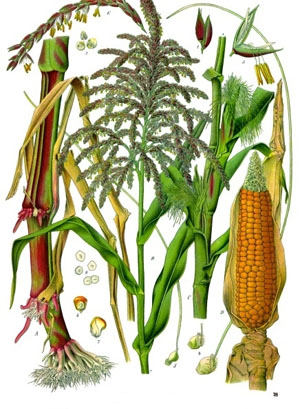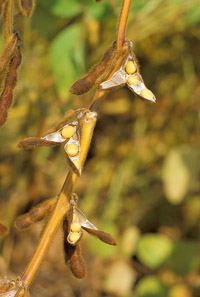Striga - a parasitic weed with a very wide geographic distribution that can have devastating effects upon crops, particularly those planted by subsistence farmers - is treated here as a pest.
Chickpea
US scientists develop pest-resistant chickpea (August 2009)
Chickpeas, high in protein, fiber and other nutrients, are important legume crops the world over. But humans aren't the only consumers: the larval stage of the beet armyworm moth likes to eat the crop's leaves. But new lines of resistant chickpeas developed by Agricultural Research Service (ARS) scientists and their collaborators could put the kibosh on this crop-damaging pest's voracious appetite, and potentially save on chemical insecticides used to fight it.
Cotton
Austro-Indian non-GM research cuts 50% of cotton insecticides, adds 75% profitability (June 2007) A relatively low-tech approach to managing pests promises to help hundreds of thousands of cotton farmers across Asia raise yields and reduce environmental contamination. U.Va. biologist Michael Timko helps Africans breed disease-resistant plant.
A relatively low-tech approach to managing pests promises to help hundreds of thousands of cotton farmers across Asia raise yields and reduce environmental contamination. U.Va. biologist Michael Timko helps Africans breed disease-resistant plant.
Non-pesticide, non-GM cotton pest management success in India (June 2007)
A relatively low-tech approach to managing pests promises to help hundreds of thousands of cotton farmers across Asia raise yields and reduce environmental contamination.
Cowpea
 IITA releases non-GM high-yielding Striga-resistant cowpeas (March 2009)
IITA releases non-GM high-yielding Striga-resistant cowpeas (March 2009)
Resource-poor cowpea farmers in sub-Saharan Africa have seen their profits jump by 55 per cent thanks to improved dual-purpose cowpea varieties developed and introduced by IITA and its national partners in Nigeria. Paul Amaza, IITA Agricultural Economist, says that farmers who use traditional varieties earn about US$ 251 per hectare, while those who are growing the improved cowpea are getting US$390, or US$139 more, per hectare with proper crop management.
Non-GM approach to Striga-resistant cowpeas in Africa (July 2007)
 Maize
Maize
Striga-resistant maize developed by Kenyan scientist (May 2013)
Drought-tolerant and striga-resistant maize released in Ghana (April 2010)
Ghana has released four Quality Protein Maize varieties tolerant of drought and resistant to striga hermontica - a parasitic weed that reduces maize yield - to farmers to boost maize production in drought-prone areas of the country.
IITA (Nigeria) launches new non-GM striga-resistant maize varieties (December 2008)
Maize farmers in West and Central Africa (WCA) could soon enjoy increased harvests and reduced crop losses due to Striga with the introduction of two new resistant varieties - TZLComp1Syn W-1 (Sammaz 16) and IWDC2SynF2 (Sammaz 15) — developed by IITA in partnership with the Institute for Agricultural Research (IAR), Zaria, Nigeria.
Body blow to grain borer – pest-resistant maize (October 2007)
The larger grain borer is taking a beating from CIMMYT (Internation Maize and Wheat Improvement Centre) breeders in Kenya as a new non-GM African maize withstands the onslaught of one of the most damaging pests.
Pepper
US researchers develop pest-resistant pepper (September 2009)
A new red-fruited habanero is the latest pepper with resistance to root-knot nematodes to be released by Agricultural Research Service (ARS) scientists.
 Potato
Potato
Researchers at the James Hutton Institute in the UK develop potato cyst nematode-resistant potatoes (September 2024)
The potato cyst nematode-resistant potatoes were developed using marker assisted selection, a biotechnology that doesn't result in a GMO. (Coverage starts at 08:25 mins in the BBC recording; there's also an article here.)
Cornell researchers release scab- and nematode-resistant potatoes (March 2011)
US researchers develop non-GM pest-resistant potato (March 2009)
Despite their microscopic size, Columbia root-knot nematodes (CRN) have potential to inflict huge losses – about $40 million annually – by tunneling into potatoes to feed. But this level of loss isn’t likely to happen, thanks to fumigants growers now use – at a cost of $20 million annually.
Rice
Rice-animal co-culture farming increases yields, cuts pesticide use (April 2023)
Rice-animal co-culture farming (e.g., rice-fish, rice-duck, and rice-crayfish), an ancient SE Asian practice, increases rice yields, cuts pesticide use and reduces nitrogen runoff, leaching, and methane emissions compared to monoculture farming.
Sorghum
Africa: researchers start to develop non-GM striga resistant sorghum (June 2010)
 Soy
Soy
Organic farmer develops aphid-resistant soybeans (August 2010)
US scientists develop non-GE soybean line resisting key nematode (December 2009)
A new soybean line developed by Agricultural Research Service (ARS) scientists is good news for growers. The line, JTN-5109, is effective against the most virulent soybean cyst nematode, called LY1.
Midwest farmers grow aphid-resistant soybean (August 2009)
This year farmers in the Midwest are growing a new variety of soybeans developed by University of Illinois researchers that has resistance to soybean aphids.
High-yielding, soybean cyst nematodes-resistant non-GM soybeans (July 2007)
Soybean growers now have more options when selecting soybean varieties that have high yield potential and the ability to stave off soybean cyst nematodes. SCN, a tiny worm that infests the soil in many fields in Iowa and the rest of the Midwest, steals soybean yields.
Sweet potato
Weed- and insect-resistant, high yield sweet potato (January 2023)
Developed by breeding and selection. USDA press release is here.
New not-so-sweet potato resists pests and disease (June 2011)
Tomato
New tomato bred to naturally resist pests and curb disease (January 2023)
A Cornell researcher has completed a decades-long program to develop new varieties of tomato that naturally resist pests and limit transfer of viral disease by insects.
Wheat
Insect- and pest-resistant super wheat (August 2010)
Miscellaneous
"Push-pull" pest control to reach more African farmers (April 2011)









